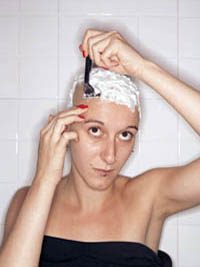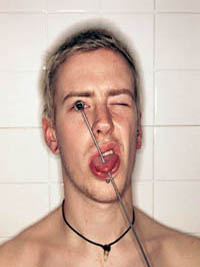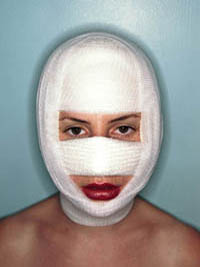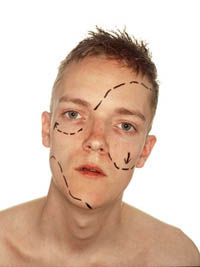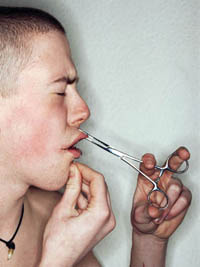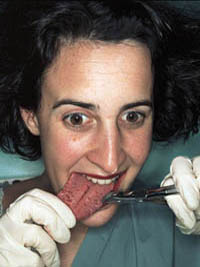Photographer Neil Bradley-Young (b. 1978) was one of the new talents exhibiting in Pay & Display exhibition at the Old Truman Brewery, Atlantis Gallery, London. This group show, which was held at the end of June, introduced the work of new graduates to the British Arts scene. Bradley-Young's work "Rituals" was one of the strongest works in the show. "Rituals" is a set of images which discusses the role of body manipulation in relation to sense of selfhood.
Where did the title Rituals came from?
We usually think of rituals in terms of religious ceremony. However, I believe that the compulsion to mutilate ones body, whether in the form of cosmetic surgery, haircutting, or self-harming the flesh can be seen as forms of secular ritual within the context of post-Freudian pop-culture. The term "Rituals" suggests that each act has a purpose and meaning for the individual involved, which can be conveyed to the viewer.
So are you referring to fetishism with this work?
I believe that some kind of fetishism is inherent in all photography. It has been suggested that almost any act can become the subject of fetishism. I think that sexuality is a big motivation for most of us – from deciding which shirt to put on in the morning, to engineering a desirable face for ourselves or using metal implants to conform to a particular subculture. We all want to desire and to be desired by others; in this sense fetishism can be seen as another system of this desire, and as such has become an important theme within my work.
In your work - What is the relationship between the concept of beauty and the mutilation of flesh?
For some people, the mutilation of flesh in the form of piercing or scarification is considered to be a form of beautification – for others it is a process of destruction of natural beauty. Of course, cosmetic interference or an extreme haircut can be considered in similar terms. I'm not suggesting that manipulating the body is good or bad, just that it happens, and hopefully causing people to re-evaluate the psycho-sexual significance of the way we treat our bodies and our reactions to the way others treat theirs. We often become too comfortable with our own perception of the external image of others, when that image is altered it can throw that whole process of identification out of the window and really begin to threaten our own sense of self – that's what fascinates me. Just imagine if Enrique Englasias had his mole removed or Ana Kornikova cut her hair short...the press would have field day!
Why has the cutting of hair been important in your work?
When I left school, I trained as a hairstylist. Because I have seen the other side of the hair industry – I can identify with the subtle violence of haircutting. For example, when a person comes into the salon with extremely long hair, requesting that it all be cut off, its not just about fashion anymore, its about the complex psychology of self image.
There seems to be a sense of humour in your work. – Did you choose to use humour in you work in order to make your subject mater easier to digest?
The sense of humour came about naturally – I wanted to create something which could be considered obscenely anarchic, and one way of expressing this was to create an undertone of black comedy. It's like saying, this is what we are capable of and these people have a personality. It's like the kind of black humour you might find in the back room of an undertaker.
The style of your work seems to reflect contemporary British fashion photography?
I guess that is true. I like to use contemporary lighting techniques such as ring-flash, to create images that people can relate to, which look like they could have been taken from an advertising campaign for example. I think that many people in Britain identify with advertising images, maybe even allowing them to influence their perception of their own self-identity – I like the idea of being able to subvert that process.
But also you claim to be influenced by Scandinavian style and design?
That is also true. I have spent several months in Finland, and I have also travelled in south Sweden. Even before I came to Finland for the first time, I read an article about Finnish youth culture, which was illustrated with fantastic portraits – shot in various Helsinki bars and night-clubs. Those portraits have since stuck in my mind and have had a stylistic influence on my current work. London is very different scene, much more hectic, and a bit too commercially orientated in my opinion. I have found it easy to relax and find creative people to work with in Finland – I'm looking forward to working and exhibiting here again whenever I get the chance.
Neil Bradley-Young: British, born on south east coast of England, Margate 1978
Education: Learned his craft at "City of Westminster College School of Photography" from 1998-2001, were he gained a National Diploma in (Design) Photography and an Higher National Diploma in Photography - both with Distinction grades. Accepted 2nd year entry into the BA(Hons) Photographic Arts degree at The University of Westminster. 2001-2003 Where he was awarded First Class Honours.
Previous exhibitions:
2000 Multiple Exposure: Group Show The Cockpit Gateforth Street London NW8 8TH
2002 Terra Torii Lock & Davis Gallery 89 Goldsmiths Row London E2 8QR
Pictures: Neil Bradley-Young

